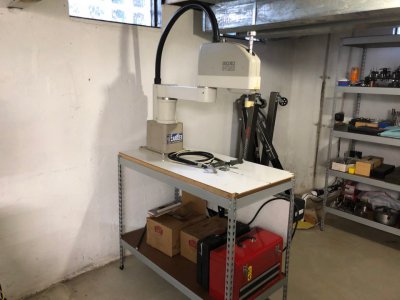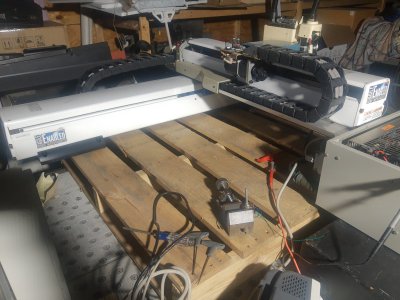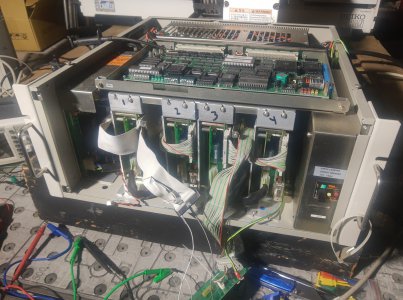Finally had some time to get back to the robot.
I was able to get a 32 bit laptop from a friend that runs the old spel programing software. Everything seems to work on the machine. Jogging in the software was easy to figure out. I still need to learn to write an actual program. I was able to use a IDE floppy ribbon in place of the factory servo drive cable which allowed me to probe the pins while running. I new right away when I saw -5v hope for a pulse/dir input was probably dashed. Probing around I have figured out the power +24, +5, -5, the drive enable, and the motor encoder pins go to the robot MPU then straight thru to the drives. Whats handy is the individual drives can be "ignored" by the MPU with some DIP switches. Also, the drives can individually be un-enabled from the jog/ program software window to allow manually positioning the axis. This was super helpful to determine the pinouts.
Couple of questions:
Is this project worthy of a new thread? It may go months between updates. The goal is using the robot for a DIY plasma table.
Second, Anyone familiar with velocity controlled servos? From what I can tell so far the drives only command the speed of the motor. The robot processor does the control loop. When the motor drive is enabled (and the MPU is set to ignore it) the servo is totally limp. Turning the motor by hand doesn't seem to fualt the drive. Which makes sense considering the software has a function to allow the axis to be moved manually for programing. This means (i think) the drive does no pulse counting or position traking. Does this make sense? I was able to enable a drive and use a pot to send voltage to the velocity input and move the axis in both directions. Moving the pot very rapidly cuased the drive to fualt. Unfortunately, I couldn't find what drive pin output the fault becuase the MPU killed power to 24v, 5 and -5v not just the buss rail.
Next is to write an actual program. Probably just X moving back and forth 20' or so. In jog mode the max travel speed is limited to 5%. I need to move an axis close to max speed to measure what the max command voltage is going to the drive. Also hope the figure out if the 5% limit is fully implemented in the MPU or the servo drive itself. Some of the yaskawa drive manuals (for different drives, can't find info on the ones in the robot) have speed limit settings that can be set by taking pins H or L.
Thanks for the offer on the converter boards. Still hoping to use the OEM drives. Looks like I will have to make a pulse counter and pid controller for each axis.




